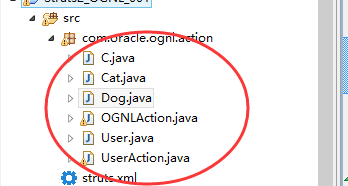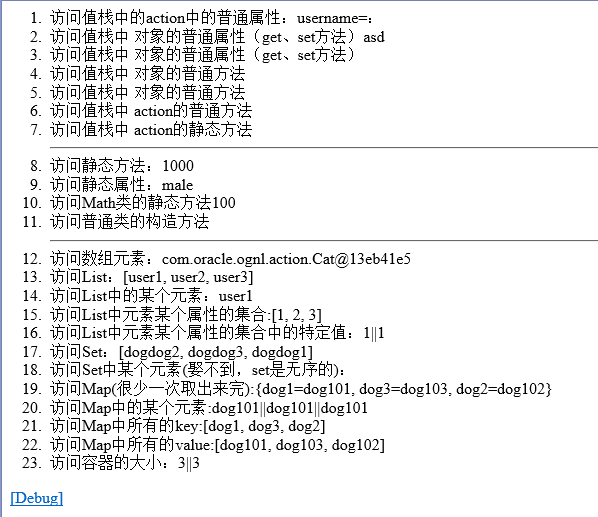OGNL取Map,List,Set的值
2024-08-27 02:58:37
用到的类有:

相应代码:
public class Dog {
private String name;
public Dog(){
}
public Dog(String name){
this.name = name;
}
public String getName() {
return name;
}
public void setName(String name) {
this.name = name;
}
@Override
public String toString() {
return "dog"+name;
}
}
public class Cat {
private Dog friend;
private String name;
public Cat(){}
public Cat(String name) {
this.name = name;
}
public String getName() {
return name;
}
public void setName(String name) {
this.name = name;
}
private int age;
public int getAge() {
return age;
}
public void setAge(int age) {
this.age = age;
}
public Dog getFriend() {
return friend;
}
public void setFriend(Dog friend) {
this.friend = friend;
}
public String miao(){
return "miao";
}
public static int leg(){
return 4;
}
}
public class User {
private String name;
private int age;
public User(String name, int age) {
this.name = name;
this.age = age;
}
public User(){
}
public User(int age){
this.age = age;
}
public String getName() {
return name;
}
@Override
public String toString() {
return "user"+age;
}
public void setName(String name) {
this.name = name;
}
public int getAge() {
return age;
}
public void setAge(int age) {
this.age = age;
}
}
public class UserAction extends ActionSupport{
/*private String username;
private String password;
public String getUsername() {
return username;
}
public void setUsername(String username) {
this.username = username;
}
public String getPassword() {
return password;
}
public void setPassword(String password) {
this.password = password;
}*/
private User user;
public User getUser() {
return user;
}
public void setUser(User user) {
this.user = user;
}
private Cat cat;
public Cat getCat() {
return cat;
}
public void setCat(Cat cat) {
this.cat = cat;
}
private List<User> users = new ArrayList<User>();
private Set<Dog> dogs = new HashSet<Dog>();
private Map<String,Dog> dogMap = new HashMap<String,Dog>();
private Cat[] cats = new Cat[5];
public Cat[] getCats() {
return cats;
}
public void setCats(Cat[] cats) {
this.cats = cats;
}
public List<User> getUsers() {
return users;
}
public void setUsers(List<User> users) {
this.users = users;
}
public Set<Dog> getDogs() {
return dogs;
}
public void setDogs(Set<Dog> dogs) {
this.dogs = dogs;
}
public Map<String, Dog> getDogMap() {
return dogMap;
}
public void setDogMap(Map<String, Dog> dogMap) {
this.dogMap = dogMap;
}
public UserAction(){
cats[0] = new Cat("cat1");
cats[1] = new Cat("cat2");
cats[2] = new Cat("cat3");
users.add(new User(1));
users.add(new User(2));
users.add(new User(3));
dogs.add(new Dog("dog1"));
dogs.add(new Dog("dog2"));
dogs.add(new Dog("dog3"));
dogMap.put("dog1", new Dog("101"));
dogMap.put("dog2", new Dog("102"));
dogMap.put("dog3", new Dog("103"));
}
public String execute() throws Exception {
return SUCCESS;
}
/*public int fun(){
return 250;
}
public static int fun2(){
return 500;
}*/
}
在UserAction里new 几个Map、Set、List,生成相应的get、set方法。
对应的ognl的html代码:
<body>
<ol>
<li>访问值栈中的action中的普通属性:username=:<s:property value="username"/></li>
<li>访问值栈中 对象的普通属性(get、set方法)<s:property value="user.name"/></li>
<li>访问值栈中 对象的普通属性(get、set方法)<s:property value="cat.friend.name"/></li>
<li>访问值栈中 对象的普通方法<s:property value="cat.miao()"/></li>
<li>访问值栈中 对象的普通方法<s:property value="cat.leg()"/></li>
<li>访问值栈中 action的普通方法<s:property value="fun()"/></li>
<li>访问值栈中 action的静态方法<s:property value="fun2()"/></li>
<hr>
<li>访问静态方法:<s:property value="@com.oracle.ognl.action.C@ccc()"/></li>
<li>访问静态属性:<s:property value="@com.oracle.ognl.action.C@sex"/></li>
<li>访问Math类的静态方法<s:property value="@@max(10,100)"/></li>
<li>访问普通类的构造方法<s:property value="new com.oracle.action.Cat('sdf')"/></li>
<hr>
<li>访问数组元素:<s:property value="cats"/></li>
<li>访问List:<s:property value="users"/></li>
<li>访问List中的某个元素:<s:property value="users[0]"/> <li>访问List中元素某个属性的集合:<s:property value="users.{age}"/></li>
<li>访问List中元素某个属性的集合中的特定值:<s:property value="users.{age}[0]"/>||<s:property value="users[0].age"/></li>
<li>访问Set:<s:property value="dogs"/></li>
<li>访问Set中某个元素(娶不到,set是无序的):<s:property value="dogs[1]"/></li>
<li>访问Map(很少一次取出来完):<s:property value="dogMap"/></li>
<li>访问Map中的某个元素:<s:property value="dogMap.dog1"/>||<s:property value="dogMap['dog1']"/>||<s:property value="dogMap[\"dog1\"]"/></li>
<li>访问Map中所有的key:<s:property value="dogMap.keys"/></li>
<li>访问Map中所有的value:<s:property value="dogMap.values"/></li>
<li>访问容器的大小:<s:property value="dogMap.size()"/>||<s:property value="users.size"/></li> </ol>
<s:debug></s:debug>
</body>
效果:

最新文章
- [LeetCode] Closest Binary Search Tree Value 最近的二分搜索树的值
- Linux第三周——跟踪分析内核的启动过程
- python实现支持并发、断点续传的Ftp程序
- 数据库优化实践【TSQL篇】
- Qt 二级菜单栏 中文无法输入问题
- flexible.js
- Cocos2d-JS坐标系
- HttpClient post中文乱码解决
- 【转】理解 Android Build 系统----不错
- 扩展jquery.validate自定义验证,自定义提示,本地化
- 首次在C#程序中用log4net
- Rewrite JSON project with Fetch
- COOKIE和SESSION之间的区别以及用法
- python----re正则模块详解
- Delaunay triangulation
- Pytorch安装(基于anaconda虚拟环境)
- maven 引入外部jar包的几种方式
- 万恶之源 - Python初识函数
- php不用递归完成无限分类,从表设计入手完整演示过程
- C#基础学习之委托的理解和应用